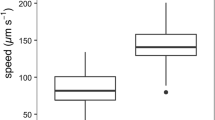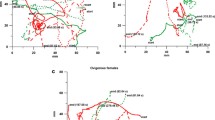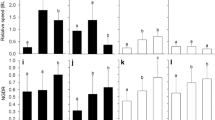Abstract
Laboratory experiments showed that both cladocerans and copepods are able to overcome a filamentous algae barrier, and are able to move within algal mats. This suggests that the crustaceans noted in large numbers in accumulations of algae actively colonize these mats and live inside of them.
Similar content being viewed by others
References
Dodson, S. & C. Ramcharan, 1991. Size-specific swimming behavior of Daphnia pulex. J. Plankton Res. 13: 1367–1379.
Gliwicz, Z. M. & J. I. Rybak, 1976. Zooplankton. In E. Pieczyńska (ed.), Selected problems of lake littoral ecology. Wyd. Uniwersytetu Warszawskiego, Warszawa: 69–96.
Guranowska, G. M., 1975. Copepoda i Cladocera towarcyszace masowym pojawom glonów nitkowatych [Copepods and cladocerans accompanying the mass appearances of filamentous algae]. M. Sc. Thesis, University of Warsaw, Warszawa, 13 pp.
Hillebrand, H., 1983. Development and dynamics of floating clusters of filamentous algae. In R. G. Wetzel (ed.), Periphyton of freshwater ecosystems, Dr W. Junk Publishers, The Hague: 31–39.
Kerfoot, W. C., D. L. Kellogg, Jr. & J. R. Strickler, 1980. Visual observations of live zooplankters: evasion, escape, and chemical defenses. In W. C. Kerfoot (ed.), Evolution and Ecology of Zooplankton Communities. The University Press of New England, Hanover (N. H.): 10–27.
Moss, B., 1990. Engineering and biological approaches to the restoration from eutrophication of shallow lakes in which aquatic plant communities are important components. In R. D. Gulati, E. H. R. R. Lammens, M. L. Meijer & E. van Donk (eds), Biomanipulation — tool for water management. Hydrobiologia 200/201 (Dev. Hydrobiol. 61): 367–377.
Ozimek, T., 1990. Aspect of the ecology of a filamentous alga in a eutrophicated lake. Hydrobiologia 191: 23–27.
Pieczyńska, E., T. Ozimek & J. I. Rybak, 1988. Long-term changes in littoral habitats and communities in Lake Mikołajskie (Poland). Int. Revue ges. Hydrobiol. 73: 361–378.
Schriver, P., J. Bøgestrand, E. Jeppesen & M. Søndergaard, 1995. Impact of submerged macrophytes on fish-zooplankton-phytoplankton interactions: large-scale enclosure experiments in a shallow eutrophic lake. Freshwat. Biol. 33: 255–270.
Woroniecka, U. D., 1974. Fauna towarzyszaca masowym pojawom glonów nitkowatych [The fauna accompanying the mass appearances of filamentous algae]. M. Sc. Thesis, University of Warsaw, Warszawa, 24 pp.
Author information
Authors and Affiliations
Rights and permissions
About this article
Cite this article
Rybak, J.I. The swimming behavior of planktonic crustaceans colonizing algal mats. Hydrobiologia 337, 183–186 (1996). https://doi.org/10.1007/BF00028519
Received:
Revised:
Accepted:
Published:
Issue Date:
DOI: https://doi.org/10.1007/BF00028519




